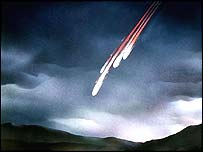This is the mass extinction event that occurred 250 million years ago, and which paved the way for the beginning of the reign of the dinosaurs

After it was almost completely clear that an asteroid that collided with the Earth caused the extinction of the dinosaurs along with over 90 percent of the species that stayed with them on the Earth, 65 million years ago, scientists recently found new evidence that the greatest extinction in the history of the Earth was also caused by an asteroid. This is the mass extinction event that occurred 250 million years ago, and which cleared the way for the beginning of the reign of the dinosaurs.
New geological evidence suggests that the "Great Death" was caused by a space rock crashing into Earth. Dozens of rare mineral grains discovered in ancient rock in Antarctica may be the "smoking gun". American scientists now claim.
Ashish Basu, a geochemist at the University of Rochester, New York, believes that these rocks are from the boundary between the Freeman and Tertiary periods, 251 million years ago, when about 90 percent of marine life and 70 percent of terrestrial species became extinct. If indeed this is the case, this is the second known extinction caused by an asteroid. "There appear to have been two major extinctions in Earth's history, both of which were caused by catastrophic collisions with chondrite meteorites." Basso said in an article he wrote together with four colleagues from other American universities in the journal Science.
This is the latest in a series of evidence supporting the theory that a celestial body hit the Earth at the same time as the Great Death. In 2001, American researchers discovered tiny capsules of cosmic gas trapped in rocks from the said border. Isotopes of helium and argon that are very common in space have been found inside a structure made of carbon atoms. These strange, ball-shaped molecules are known as buckyballs or fullerenes, and they most certainly originate from a space rock that collided with Earth.
However, not all scientists are convinced of the theory that the extinction was caused by an asteroid collision. "The fossil data show that many species of animals and plants, mainly terrestrial, could survive in any case. Four out of six evolutionary lines of lizard-like reptiles called procolophonoids survived until the end of the dinosaur era. The question of how vertebrates could have survived such a disaster still remains a mystery.
